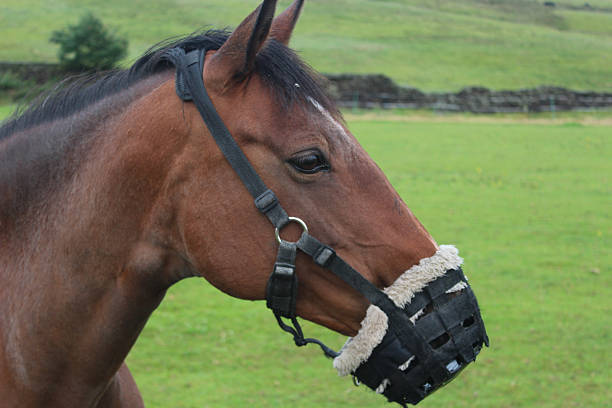Last Updated on February 21, 2022 by Allison Price
The grazing muzzles were first introduced in 1990 and were widely praised by horse owners. The grazing muzzle is a basket that fits over the lower portion of the horse’s head. It allows the pony or horse to eat the grass and only the small amount that sticks up through the hole in the plastic plate. The grazing muzzle allows horses to go out in the pasture with their friends, get exercise whenever they like, drink water as often as they wish, eat less or more frequently, and still consume a small amount of forage. Many horses have lost excess bodyweight by consuming less lush grass and are now at lower risk of developing colic or laminitis.
In a U.K. study, four mature ponies were tested to see if grazing muzzles reduced forage intake. Two ponies were grazed with grazing muzzles while the other two ponies were free to graze without them. To collect urine and feces during grazing, ponies were fitted with harnesses and were weighed prior to and after each period. All ponies were familiar with the collection harnesses and grazing muzzles at the start of the study. The ponies were given water and hay when they weren’t grazing. They were given light exercise for 30 minutes two to three days a week.

The results showed that there was a wide range in the amount of pasture grass consumed by both muzzled and unsmilled ponies during each period. The average pasture dry matter intake of ponies with muzzles was 83% lower than that of ponies without muzzles.
The behavior of the unmuzzled ponies was similar to that observed in overweight horses. These ponies were only allowed to be out for three hours per day, and they used their grazing time well. They ate with serious intent, took few breaks, played with their pasture buddies, and engaged in many other activities that are common in horses who are left alone at the pasture. They ate between half and two-thirds (or more) of their daily dry matter requirements in three hours. Moderate reductions in pasture time may not result in the weight loss that owners expect. Muzzling allows horses to spend more time in pasture and reduces their forage intake.
Although the grazing muzzle is effective in restricting horses’ intake of carbohydrate rich grass, some horses have demonstrated remarkable persistence and ingenuity by pulling, pushing, or scraping the muzzle from its place so that they can continue to eat as normal. Manufacturers have changed the design of their muzzles so that this problem is now less prevalent than it was when they were first introduced.

